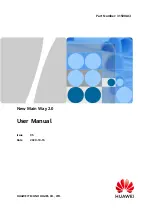
is, to the protected line circuit, does usually not result in inrush currents high
enough to be detected by the differential protection. This is especially the case if
the tap power transformer is connected at a junction somewhere towards the middle
of the protected line circuit, because the inrush phenomenon is effectively
prevented in such cases. If a start signal is nevertheless issued by the differential
protection, then the 2
nd
harmonic will prevent an unwanted trip. Observe that the
harmonic inhibit algorithm is active as long as the bias current is below 125% of
the base current
IBase
. (If there is an in-line power transformer included in the
protected line circuit, then the harmonic inhibit algorithm is permanently activated,
and can only be overridden if an internal fault has been detected.)
tIdMinHigh
M12541-177 v4
This setting defines the time that
IdMinHigh
will be active after the previously
dead protected circuit has been connected to the power source. If a power
transformer is included in the protection zone, due to long duration of transformer
inrush current the parameter should be set to 60 s. Otherwise a setting of 1 s is
sufficient.
IdUnre
M12541-180 v5
IdUnre
is set as a multiple of
IBase
. Values of differential currents above the
unrestrained limit generate a trip disregarding all other criteria, that is, irrespective
of the internal or external fault discriminator and any presence of harmonics. It is
intended for fast tripping of internal faults with high fault currents. The
recommended setting is 120% of the highest through fault current that can appear
on the protected line. Consequently, to set this value properly, the fault current
must be calculated in each specific case.
For a short line or a situation with a 1½ breaker bay, the through fault current might
be practically the same as the differential current at an internal fault. Extreme
unequal CT saturation at external faults could then be a risk of unwanted operation
if the unrestrained operation is used. Consequently, if the through fault currents can
be of the same order as the maximum differential currents at internal faults, for
example, when there is a source of power only on one side (in the branch with the
first CT), and only load on the other side (in the branch with the other CT), it is
recommended to refrain from using the unrestrained operation, by setting the max
value
IdUnre
= 50 ×
IBase
.
On long lines, the through fault current is often considerably less than the
maximum differential current at internal faults, and a suitable setting of the
unrestrained level is then easy to calculate.
When a transformer is included in the protected zone, the maximum inrush current
must be considered when the unrestrained level is calculated. The inrush current
appears from one side of the transformer, while the maximum differential current at
internal faults is limited by the source impedances on all sides of the transformer.
Observe that if the power transformer is energized via a power line, even a short
one, the inrush phenomenon is much less pronounced. The fundamental frequency
of the inrush current will not be as high as when the power transformer is
connected directly to a source with very low internal impedance.
Section 6
1MRK 505 393-UEN B
Differential protection
90
Line differential protection RED650 2.2 IEC
Application manual
Summary of Contents for RED650
Page 1: ...RELION 650 SERIES Line differential protection RED650 Version 2 2 Application manual ...
Page 2: ......
Page 22: ...16 ...
Page 32: ...26 ...
Page 82: ...76 ...
Page 112: ...106 ...
Page 152: ...146 ...
Page 208: ...202 ...
Page 214: ...208 ...
Page 282: ...276 ...
Page 356: ...350 ...
Page 404: ...398 ...
Page 408: ...402 ...
Page 442: ...436 ...
Page 452: ...446 ...
Page 453: ...447 ...












































